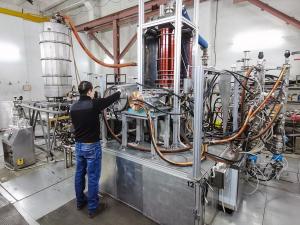Russia ships auxiliary heating equipment
The energy-generating devices of ITER's electron cyclotron heating system—gyrotrons—require a number of auxiliary systems such as water cooling equipment, cryocoolers and microwave-beam forming systems. A first batch of auxiliaries is on its way now from Nizhny Novgorod, Russia.
At ITER, two radio-wave-generating systems are designed to deliver 40 MW of input heating power to the plasma: the electron and ion cyclotron heating systems. The systems deliver energy at frequencies that match the oscillations of particles inside the plasma—a matching called "resonance." The energy increases the velocity of the particles' chaotic motion, and at the same time their temperature.
At the core of electron cyclotron resonance heating (ECRH) is the microwave-generating gyrotron. In a gyrotron, beams of electrons are accelerated toward a cavity where a strong magnetic field is applied. The interaction between the rotating (cyclotron) motion of the electrons and the magnetic field generate high-frequency radio waves that "travel" in a straight line into the plasma, almost like an optical beam.
Russia is manufacturing 8 of the 24 gyrotrons required by ITER. Six gyrotron complexes have already been completed, of which four are required to be on site by First Plasma. The Institute of Applied Physics of the Russian Academy of Sciences has been engaged in the development and scientific guidance for the creation of these unique devices, while their fabrication is carried out at the GYKOM enterprise in Nizhny Novgorod.
A first batch of auxiliary equipment was dispatched on 1 December. According to the ITER schedule, delivery of gyrotrons, power supplies, control systems, as well as the start of equipment assembly at the ITER site is planned for 2022.


